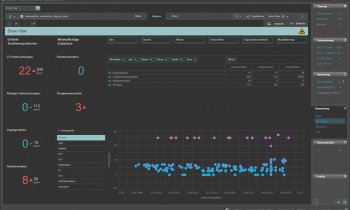News • Combination approach
Radiation treatment extends life expectancy for patients with inoperable lung cancer
Patients with unresectable, or inoperable, lung cancer are often given a dismal prognosis, with low rates of survival beyond a few years. Researchers exploring combination therapies have recently discovered improved survival rates by up to one year when patients treated with a newly formulated chemotherapy regimen are also given radiation therapy.

A group of patients with metastatic non-small-cell lung cancer (mNSCLC) who had already been enrolled in a clinical trial were given radiation therapy, in addition to their treatment with a novel chemotherapy formulation, mPEBev, which was designed for its immune-modulating and anti-angiogenic effects. The mPEBev regimen is composed of fractionated cisplatin, oral etoposide, and bevacizumab, a monoclonal antibody that inhibits blood vessel growth in the tumor. Treatments were administered metronomically, spaced out in the safest possible doses to reduce side-effects and toxicity.
“We had recently established the safety and anti-tumor activity of the mPEBev regimen in metastatic non-small-cell-lung cancer (mNSCLC),” says lead researcher Dr. Pierpaolo Correale, M.D., PhD., Director of the Oncology Unit of the Metropolitan Hospital in Reggio Calabria, Italy. “We hypothesized that in patients undergoing the mPEBev regimen, the use of radiotherapy could provide additional immunostimulation to improve their long-term survival,” Correale says. “We found that radiotherapy, together with its direct cytolytic effect on tumor tissue, also elicits systemic immunological events, similarly to cancer vaccines,” adds Prof. Luigi Pirtoli M.D., Full Professor and Director, Radiation Oncology at the University of Siena, Italy. “This response may result in the regression of distant metastases, known as the abscopal effect, as suggested by immunological mechanisms further investigated by our team in previous research.”
Dr. Correale and colleagues’ findings were recently accepted for publication in the journal Oncotarget.
This is a good example of translational research, from bench to bedside
Antonio Giordano
The authors are a multidisciplinary group of Italian researchers, led by Dr. Pierpaolo Correale (Hospital of Reggio Calabria, Italy); Prof. Luigi Pirtoli (Siena University Hospital, Italy); and Prof. Antonio Giordano, M.D., Ph.D., Director of the Sbarro Institute for Cancer Research and Molecular Medicine, Center for Biotechnology, Temple University, Philadelphia.
Researchers identified candidates for this combination therapy in a retrospective analysis of a subset of 69 patients who received the mPEBev regimen in a recent clinical trial. Forty-five of these patients were also given palliative radiotherapy treatments to one or more metastatic sites. Survival increased in the group of patients who received radiotherapy by an average of 10 months, with the longest survival of over two years. [chemotherapy vs chemotherapy + radiotherapy: 12.1 +/-2.5 (95%CI 3.35-8.6) vs 22.12 +/-4.3 (95%CI 11.9-26.087) months; P=0.015]. Survival correlated with the ability of mPEBev to induce the anticancer immune-response of peripheral dendritic cells, as well increase the antitumor activity of central-memory and effector memory-T-cells.
These results suggest that tumor irradiation may prolong the survival of NSCLC patients undergoing the mPEBev regimen, presumably by eliciting an immune-mediated effect and providing the rationale for further prospective clinical studies into this combination therapy approach. “This is a good example of translational research, from bench to bedside, where a multi-disciplinary collaboration actually developed new operative models of treatment for the most frequent malignant disease based on solid preclinical models,” concludes Prof. Giordano, MD, PhD, Director of the Sbarro Institute for Cancer Research and Molecular medicine, Center for Biotechnology, Temple University in Philadelphia.
Source: Sbarro Health Research Organization (SHRO)
29.08.2017










